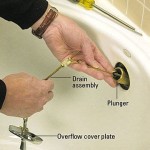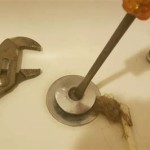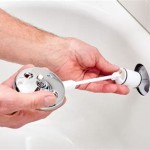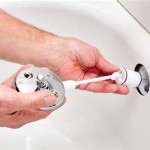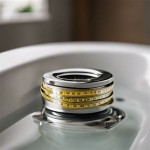Way To Clean An Acrylic Bathtub
Acrylic bathtubs offer a blend of affordability, durability, and design flexibility, making them a popular choice for modern bathrooms. Acrylic is non-porous, which contributes to its stain resistance. However, proper cleaning is essential to maintain its pristine appearance and longevity. The specific cleaning methods and products are important to preserve the acrylic's finish and prevent damage.
Regular cleaning is fundamental in maintaining an acrylic bathtub's luster. Daily use introduces soap scum, body oils, and mineral deposits that, if left unattended, can accumulate and become difficult to remove. Routine cleaning prevents this build-up and ensures that more intensive cleaning is required less frequently. This proactive approach is key to preserving the bathtub’s aesthetic appeal and extending its lifespan.
Understanding the specific vulnerabilities of acrylic is crucial for selecting appropriate cleaning agents. Abrasive cleaners, scrub brushes, and harsh chemicals can scratch and dull the surface, leading to irreversible damage. Knowing which products and tools to avoid is just as important as knowing which to use. Avoiding abrasive materials preserves the smooth, glossy finish that makes acrylic bathtubs desirable.
Safe Cleaning Solutions for Acrylic Bathtubs
Several readily available household products serve as effective and safe cleaning solutions for acrylic bathtubs. These options provide a balance between cleaning power and material safety, ensuring the bathtub remains undamaged. Options include, but are not limited to: mild dish soap, baking soda, vinegar, or specialized acrylic tub cleaners.
Mild dish soap, diluted in warm water, is a gentle yet effective everyday cleaner. Its mild formulation effectively removes soap scum and body oils without harming the acrylic surface. Applying the solution with a soft cloth or sponge and rinsing thoroughly with clean water is typically all that is needed for routine maintenance.
Baking soda, known for its mild abrasive qualities, can tackle tougher stains and grime. Creating a paste by mixing baking soda with water forms a gentle scrubbing agent. Applying this paste to the affected areas, allowing it to sit for a few minutes, and then gently scrubbing with a soft cloth or sponge helps dislodge stubborn deposits. Rinsing thoroughly is essential to remove all traces of baking soda.
Vinegar, a natural cleaning agent, is effective in dissolving mineral deposits and soap scum. A solution of equal parts white vinegar and warm water can be sprayed onto the bathtub surface. Allowing the solution to sit for 15-20 minutes before wiping clean softens deposits, facilitating easier removal. The bathtub should be rinsed thoroughly with clean water.
Commercial acrylic tub cleaners are formulated specifically for acrylic surfaces. These products consider the material's composition and typically contain non-abrasive ingredients. Always follow the manufacturer's instructions when using these cleaners to ensure optimal results and prevent damage.
Essential Cleaning Tools and Techniques
The tools used to clean an acrylic bathtub are as important as the cleaning solutions themselves. Selecting non-abrasive tools ensures that the bathtub’s surface remains scratch-free and retains its original shine. Soft cloths, sponges, and specialized cleaning brushes are essential components of an effective cleaning routine.
Microfiber cloths are ideal for cleaning acrylic surfaces. The soft, absorbent fibers gently lift dirt and grime without scratching the surface. These cloths are also effective for applying cleaning solutions and wiping the bathtub dry after rinsing.
Soft sponges, designed for delicate surfaces, are another suitable option. Selecting sponges specifically labeled as non-abrasive is crucial to avoid scratches. Using a sponge alongside a cleaning solution assists with grime removal from textured surfaces or corners.
Specialized cleaning brushes with soft bristles are helpful for reaching tight corners and crevices. These brushes are designed to agitate dirt and grime without damaging the acrylic surface. The bristles should be checked regularly for wear and tear, replacing the brush as needed to maintain its effectiveness.
When cleaning, gentle, circular motions are recommended. Applying excessive pressure can lead to scratches, even with non-abrasive tools. Letting the cleaning solution do most of the work, followed by gentle scrubbing, is the preferred method.
After cleaning, rinsing the bathtub thoroughly with clean water is important. Any remaining cleaning solution can leave a residue, attracting dirt and grime. Ensuring the bathtub is completely rinsed and then dried with a clean microfiber cloth prevents water spots and maintains its shine.
Addressing Common Acrylic Bathtub Issues
Specific issues, such as hard water stains, mildew, and scratches, require tailored cleaning approaches. Addressing these concerns promptly prevents them from becoming more severe and ensures the bathtub remains in optimal condition. Each issue necessitates a specific cleaning method and may require specialized products.
Hard water stains, caused by mineral deposits in water, can leave a dull film on the bathtub's surface. Vinegar is particularly effective in dissolving these deposits. Soaking paper towels in vinegar and applying them to the affected areas for several hours, or overnight, can soften the stains. The area can then be wiped clean and rinsed thoroughly.
Mildew, often found in damp environments, can appear as black or green spots. A solution of bleach and water (1:10 ratio) can effectively kill mildew. Spraying the affected areas with the solution, allowing it to sit for a few minutes, and then scrubbing with a soft brush and rinsing is a common treatment. Always ensure adequate ventilation while using bleach. Alternatively, commercial mildew removers specifically designed for bathrooms can be used, following the manufacturer's instructions carefully.
Minor scratches can sometimes be buffed out with specialized acrylic polishing compounds. These compounds contain fine abrasives that gently smooth the surface, reducing the visibility of scratches. Applying the compound with a soft cloth and gently rubbing in a circular motion is the typical method. Deeper scratches may require professional repair.
Preventing common issues is the most effective approach. Regularly wiping down the bathtub after each use, ensuring proper ventilation in the bathroom, and using a water softener (if hard water is a problem) can minimize the occurrence of these issues.
The frequency of deep cleaning depends on usage and environmental factors. Bathtubs used daily may require deep cleaning every one to two weeks, while those used less frequently can be cleaned less often. Regularly inspecting the bathtub for stains, mildew, or scratches helps identify potential issues early, allowing for prompt and effective treatment.

How To Clean An Acrylic Tub Or Shower 9 Best Cleaners

How To Clean An Acrylic Bathtub Lesso Blog

How To Clean An Acrylic Bathtub The Right Way

How To Clean An Acrylic Tub Or Shower 9 Best Cleaners

How To Clean An Acrylic Bathtub In 5 Simple Steps Bath

How To Clean Your Bathtub The Home Depot

How To Clean An Acrylic Bathtub

How To Clean An Acrylic Tub Or Shower 9 Best Cleaners

Acrylic Bathtub Ways To Keep It Clean Doityourself Com

How To Clean A Bathtub The Right Way In 9 Easy Steps
Related Posts

